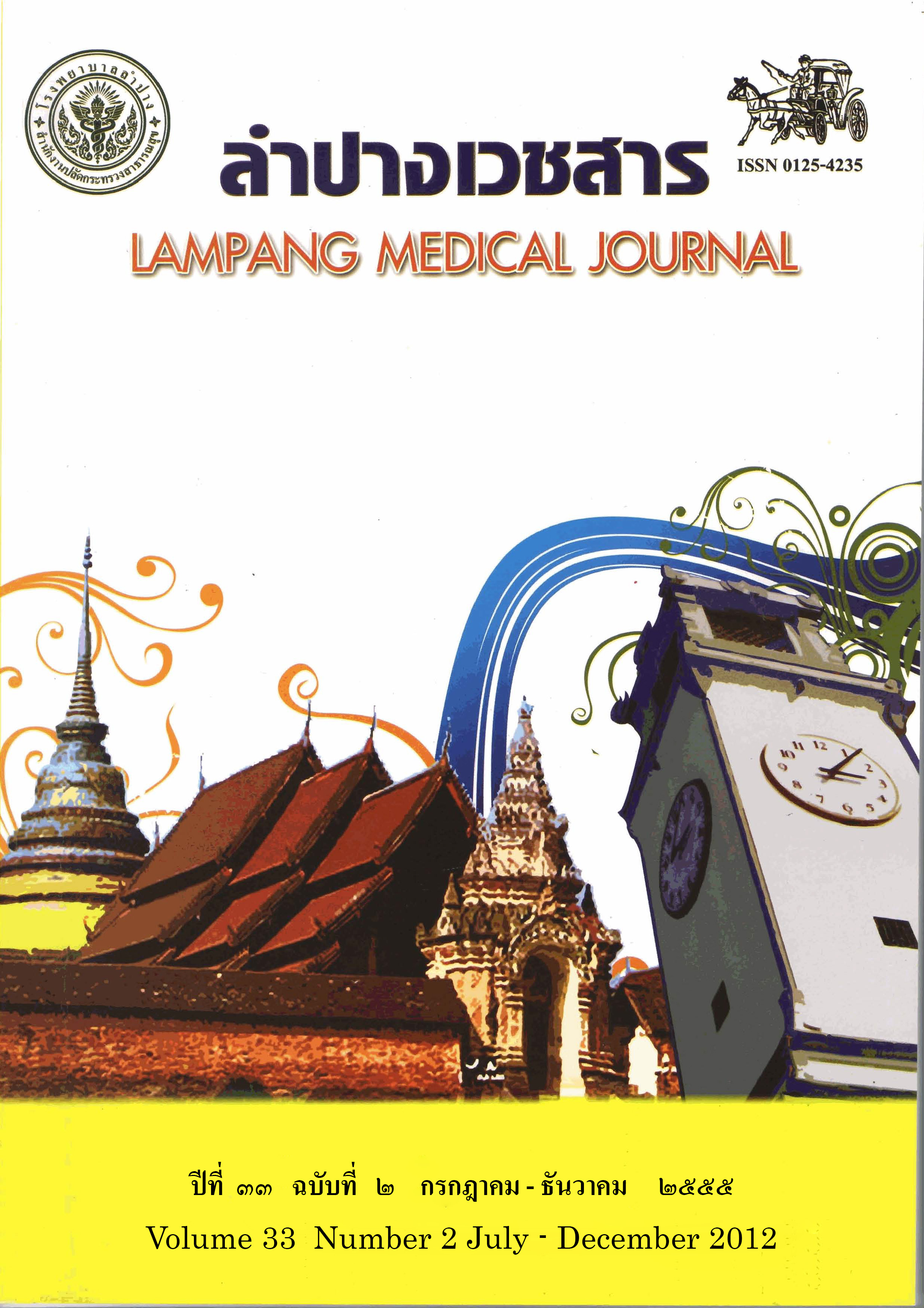Positive Predictive Value of Mammographic Report BI-RADS Category 4 and 5 Correlating with Pathologic Results in Lampang Hospital
Main Article Content
Abstract
Background : Mammography is a standard tool for detecting breast cancer. The Breast Imaging Reporting and Data System (BI-RADS) had been established for standardizing the terminology in mammographic reports on the level of suspicion. BI-RADS categories 4 and 5 indicate that biopsy and appropriate action should be taken. Its positive predictive value (PPV) has not been
studied in Lampang Hospital.
Objective: To determine PPV of mammographic reports according to the BI-RADS categories 4 and 5 for diagnosis of breast cancer.
Material and method: A retrospective study was conducted on 398 patients whom reported with BI-RADS 4 and 5 in screening and diagnostic mammography between January 2008 and December 2010 in Lampang Hospital. The findings of mammogram accompany with ultrasound were reviewed and correlated with subsequent tissue pathology. The PPV were calculated.
Results: The mean age was 52.3 ± 11.6 years (range, 24-92). Screening mammogram was performed in 31 cases and diagnostic study in 367 cases. The PPV of BI-RADS 4 was 47.8% (99/207 cases) and BI-RADS 5 was 84.8% (162/191 cases). Combined BI-RADS categories 4 and 5 yielded the PPV in screening and diagnostic groups for 58.1% and 66.2% respectively. Among 261 cases of malignancy, 77.0% was invasive ductal carcinoma and 11.9% was ductal carcinoma in situ. Fibrocystic change (41.6 %) and fibroadenoma (16.1%) were the most common findings in 137 patients with benign lesions.
Conclusion: PPV of BI-RADS category 4 and 5 for detecting breast cancer in Lampang Hospital was comparable with other previous studies. However, preoperative biopsy should be obtained in all suspicious mammographic findings because of the overlap in radiological appearances of benign and malignant lesions.
Article Details

This work is licensed under a Creative Commons Attribution-NonCommercial-NoDerivatives 4.0 International License.
บทความที่ส่งมาลงพิมพ์ต้องไม่เคยพิมพ์หรือกำลังได้รับการพิจารณาตีพิมพ์ในวารสารอื่น เนื้อหาในบทความต้องเป็นผลงานของผู้นิพนธ์เอง ไม่ได้ลอกเลียนหรือตัดทอนจากบทความอื่น โดยไม่ได้รับอนุญาตหรือไม่ได้อ้างอิงอย่างเหมาะสม การแก้ไขหรือให้ข้อมูลเพิ่มเติมแก่กองบรรณาธิการ จะต้องเสร็จสิ้นเป็นที่เรียบร้อยก่อนจะได้รับพิจารณาตีพิมพ์ และบทความที่ตีพิมพ์แล้วเป็นสมบัติ ของลำปางเวชสาร
References
Althuis MD, Dozier JM, Anderson WF, Devesa SS, Brinton LA. Global trends in breast cancer incidence and mortality 1973-1997. Int J Epidemiol 2005;34(2):405-12.
Parkin DM, Bray FI, Devesa SS. Cancer burden in the year 2000. The global picture. Eur J Cancer 2001;37 Suppl 8:S4-66.
Jemal A, Bray F, Center MM, Ferlay J, Ward E, Forman D. Global cancer statistics. CA Cancer J Clin 2011;61(2):69-90.
Sriplung H, Wiangnon S, Sontipong S, Sumitsawan Y, Martin N. Cancer incidence trends in Thailand, 1989-2000. Asian Pac J Cancer Prev 2006;7(2):239-44.
Tabar L, Fagerberg CJ, Gad A, Baldetorp L, Holmberg LH, Grontoft O, et al. Reduction in mortality from breast cancer after mass screening with mammography. Randomised trial from the Breast Cancer Screening Working Group of the Swedish National Board of Health and Welfare. Lancet 1985;1(8433):829-32.
Sickles EA. Mammographic features of 300 consecutive nonpalpable breast cancers. Am J Roentgenol 1986;146(4):661-3.
McKenna RJ Sr. The abnormal mammogram radiographic findings, diagnostic options, pathology, and stage of cancer diagnosis. Cancer 1994;74 Suppl 1:244-55.
American College of Radiology. ACR BI-RADS-Mammography. In: ACR Breast imaging reporting and data system atlas. 4th ed. Reston: American College of the Radiology; 2003.
Lacquement MA, Mitchell D, Hollingsworth AB. Positive predictive value of the Breast Imaging Reporting and Data System. J Am Coll Surg 1999;189(1):34-40.
Orel SG, Kay N, Reynolds C, Sullivan DC. BI-RADS categorization as a predictor of malignancy. Radiology 1999;211(3):845-50.
Tan YY, Wee SB, Tan MP, Chong BK. Positive predictive value of BI-RADS categorization in an Asian population.
Asian J Surg 2004;27(3):186-91.
Liberman L, Abramson AF, Squires FB, Glassman JR, Morris EA, Dershaw DD. The breast imaging reporting and data system: positive predictive value of mammographic features and final assessment categories. Am J Roentgenol 1998;171(1):35-40.
Hirunpat S, Tanomkiat W, Khojarern R, Arpakupakul N. Accuracy of the mammographic report category according to BIRADS. J Med Assoc Thai 2005;88(1):62-5.
Wiratkapun C, Lertsithichai P, Wibulpholprasert B. Positive predictive value of breast cancer in the lesions categorized as BI-RADS category 5. J Med Assoc Thai 2006;89(8):1253-9.
Muttarak M, Sriwichai K, Chaiwun B, Sukhamwang N. The Breast Imaging Reporting and Data System- BI-RADS: Positive predictive value of category 4 and 5 lesions. Chiang Mai Med J 2010;49(3):111-6.
Kavanagh AM, Giles GG, Mitchell H, Cawson JN. The sensitivity, specificity, and positive predictive value of screening mammography and symptomatic status. J Med Screen 2000;7(2):105-10.
Kurian AW, McClure LA, John EM, Horn-Ross PL, Ford JM, Clarke CA. Second primary breast cancer occurrence according to hormone receptor status. J Natl Cancer Inst 2009;101(15):1058-65.
Chan HHL LP, Yuen JHF, Leong LLY Conditions that mimic primary breast carcinoma on mammography and sonography. J Hong Kong Coll Radiol 2004;7:49-55.
Prado GLM, Guerra MTPM. Positive predictive value of Breast Imaging Reporting and Data System (BI-RADS) categories 3, 4 and 5. Radiol Bras 2010;43(3):171-4.


